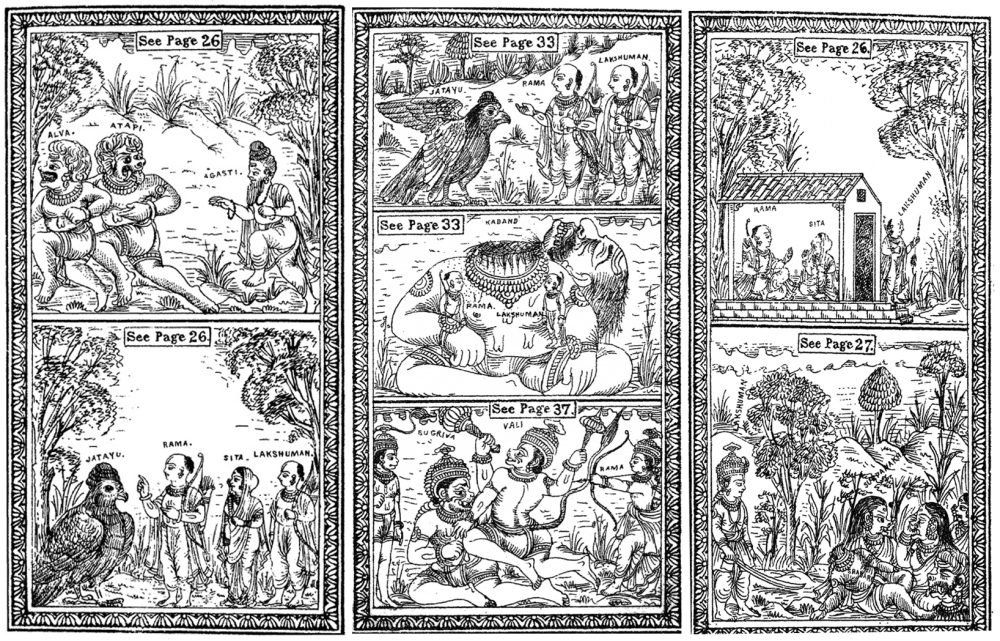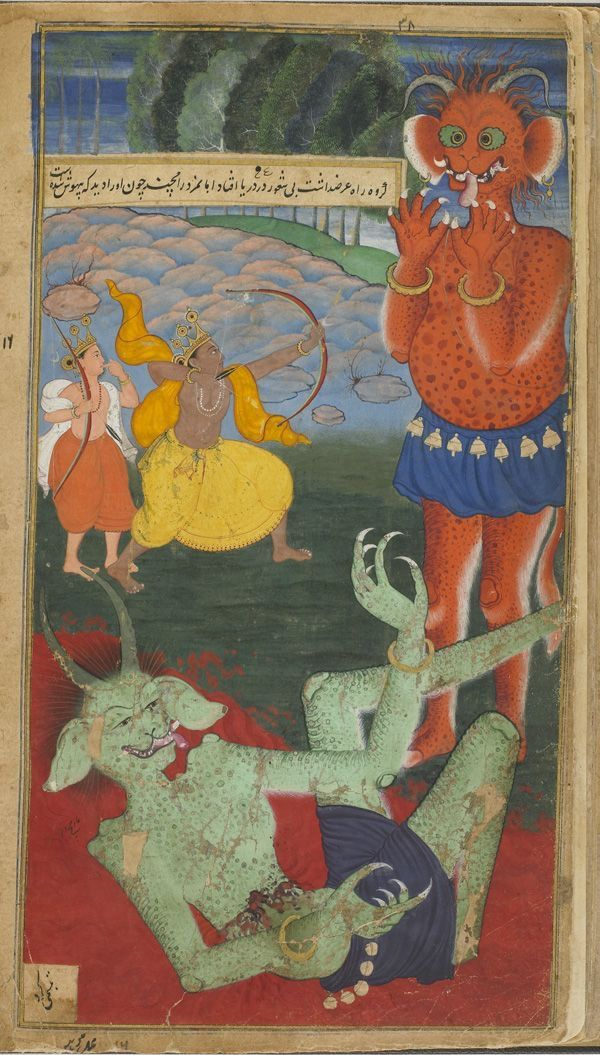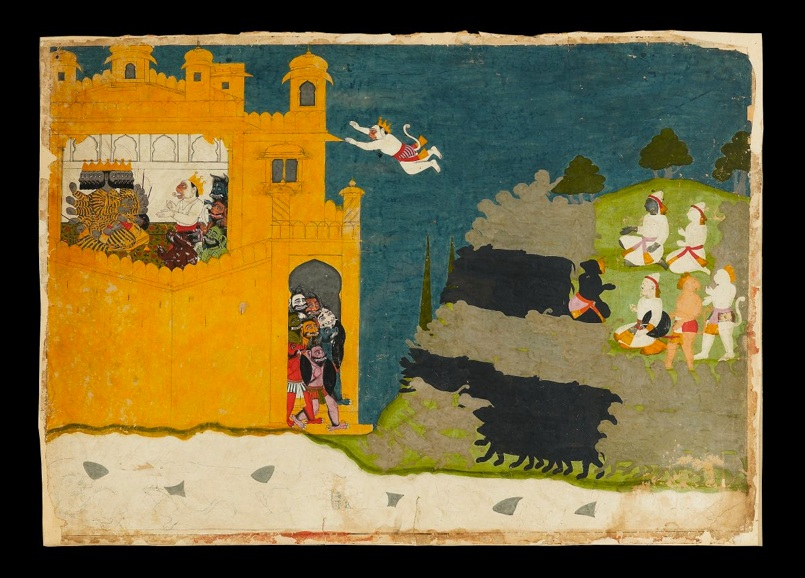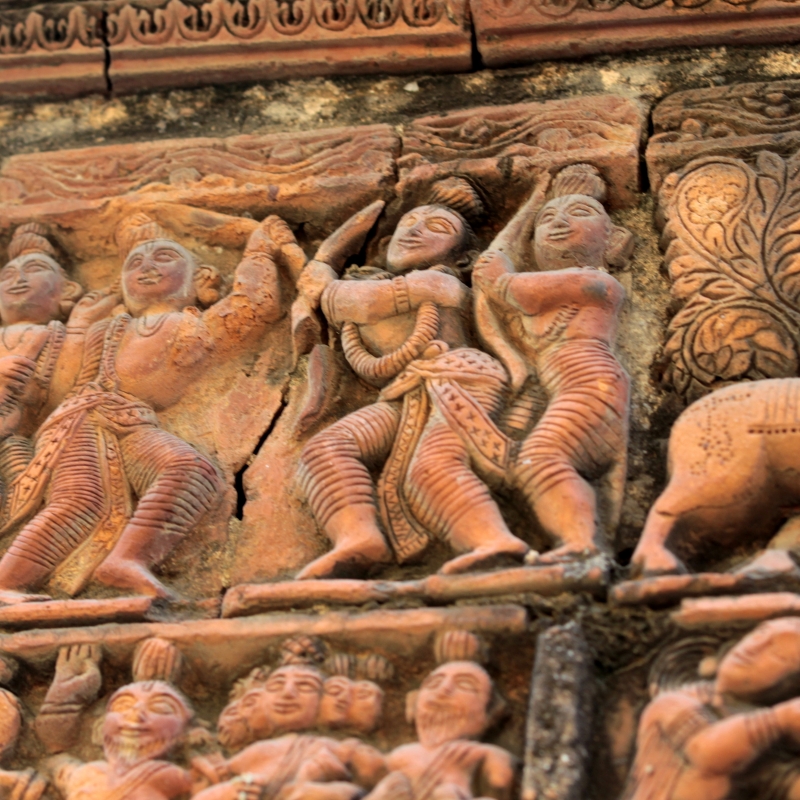. . . the cultural area in which Ramayanas are endemic has a pool of signifiers (like a gene pool), signifiers that include plots, characters, names, geography, incidents, and relationships . . . These various texts not only relate to prior texts directly, to borrow or refute, but they relate to each other through this common code or common pool. Every author . . . dips into it and brings out a unique crystallisation, a new text with a unique texture and a fresh context . . . In this sense, no text is original, yet no telling is a mere retelling—and the story has no closure, although it may be enclosed in a text.
—‘Three Hundred Ramayanas: Five Examples and Three Thoughts on Translation, A. K. Ramanujan[1]
It has been some years that the mythical figure of Rama has officially been established as the flag bearer of Hindu identity. There has been an overwhelming effort to establish a homogenous, linear Hindu identity that does not accommodate any subversion. This effort to establish one Rama and one Ramayana as the most authentic ones has been questioned by scholars such as AK Ramanujan and Paula Richman. Ramanujan’s essay ‘Three Hundred Ramayanas: Five Examples and Three Thoughts on Translation’ (1991) expounds the multiplicity of the text and questions the authenticity of the Valmiki Ramayana as the Ur text.
Along with textual retellings, the Ramayana has been retold in visual formats such as the temple murals, Mughal and Pahari miniature paintings to the patachitras, folk masks and the more recent illustrations and comics. Let us look at some of the visual representations of the text in order to trace the idea of multiplicity across genre. But before we go into the discussions of the visuals themselves, we need to understand how the ‘new text with a unique texture and fresh context,’ as AK Ramanujan puts it, works every time the text shifts from author to author, audience to audience and how Rama Katha functions within a personal as well as the public/popular contexts.
The Travelling Text
Chyavana, the son of Sage Bhrigu, was the ancestor of Valmiki. Etymologically, the word Chyavana comes from the word charana or nomads who were travelling singers chronicling the lives and history of ancient Indian kings and their exploits. Sukumar Sen, the Bengali linguist, stated that the story of Rama may have been primarily composed and sung by the nomadic bards.[2] Romila Thapar, in her book Cultural Pasts, points out:
The Mahabharta and the Ramayana . . . were originally composed by bards, the sutas, before they were taken over by brahmana authors, and the Bhrigu brahmanas in particular, who probably recorded them in a written form. The bards wandered from place to place reciting their compositions at the large sacrificial rituals conducted by the rajas or at their gatherings…the Ramayana is said to have been recited by Kusa and Lava again on a public occasion.[3]
Both instances clearly establish the origin of the Ramayana in the oral narrative tradition of India. Valmiki may have been the first industrious one to collect and record it in written form. In the same book, Romila Thapar further states: ‘The bards lived in the present and the requirement of the moment led them to adding on or sloughing off, what they thought was relevant or irrelevant either to themselves or to their patrons.’[4] The text originated in oral tradition and, like all oral narratives, it still contains within itself the core of its origin, the ability to travel and reconfigure from one interpretation to another, one perspective to another, one culture/language/gender to another. This potential to be one and multiple at the same time is probably the most essential component of its socio-cultural value. As a tradition of many stories, the Ramayana has an acute emotional potential to be expressed in aesthetic and poetic terms for the community to identify with. The text is the narrative space to articulate emotional belongingness to the stories which makes the community meaningful. As a story of a God who came down to be born as the son of man to perform lila, the text always formed emotional attachment with its readers and performers/listeners (in the case of oral traditions). These emotional involvements varied across regions, depending on class, religion, caste, ethnicity and gender. With such potential to become everybody’s, it actually could transcend social and geographical borders and be retold from different perspectives for different audiences to relate to the story from different levels of personal/social experience.
Along with textual retellings, the narrative has been retold in visual formats such as in temple murals, puppetry, performances, miniature paintings, patachitras and the more recent illustrations and comics. Each of them traces several dynamics of the interpretations and representations that constitute the multiplicity of the Rama Katha. The study of elite expressions can be instrumental in understanding patronisation and forms of circulation within an exclusive sphere, whereas the folk sphere opens up the scope for reading community imagination and a collective eye. Let us study the katha told in the visual media to understand the theme’s journey through ages and forms.
A text written in words can visibly change according to the politics/belief/location/social position/caste/gender of the author (or to the person it is attributed to). How do we understand the shifts that happen within the images that visualise the Rama Katha?
Before we try to understand how to ‘read’ the images we must keep certain factors in mind. Usually, the texts retain major components of the narrative and the authors’ own interventions are woven around these components. So, the new additions are almost spelt out, while in the case of the visuals the image makers’ interventions remain more subtle. One must align the images with the Rama Katha and understand the conditions of the artist/s to locate them. The second factor is that the Valmiki Ramyana is often assumed as the Ur or the authoritative text.[5] While authors like Tulsidas and Krittibas have paid tribute to Valimiki as the adi kavi and his Ramayana as the adi kavya in their texts, we should understand that the Rama Kathas that they had created were entirely rooted in their socio-cultural situations. So even when an author or an artist claims to follow the Valmiki Ramayana, they are actually representing the Rama Katha where cultural/regional/personal elements are bound to crawl in. And finally, when we say we ‘know’ the Ramayana, what we mean is that we remember the essence of the text, the major events and characters, and not the whole text with all its details and complexities. When we look at, for example, a Ramayana panel on the outer wall of a temple, we try to engage with the panel to understand the story, and while we connect it to the next panel or the next event, we actively recreate the story in our own minds. So, at least in the case of visual representations of the narrative, our collective memory, as well as our personal intervention, plays a major role, and one single visual may potentially give birth to multiple Rama Kathas simultaneously.
The Ramayana in Pictures: An Image Reader’s Guide
Keeping these factors in mind let us look at some of the examples to understand how a visual representation contributes to the pool of Rama narrative mirroring the cultural background, belief system, social agenda and historical components of the peoples who are/were engaged in creating them.
When we look at a visual representing an event of the narrative we can see visible signs of the artistic intervention, namely how the characters and their surroundings are imagined. More often than not the figures embody some components of the artist’s immediate reality. For example, Shri Ramavijaya, a Marathi Ramayana, was written by Shridhar Swami Nazarekar (1658–1729). Shridhar, who belonged to the Anand sect, is considered to be one of the last recognised poets of the Shivaji era.[6] In 1891, this text was translated into English and published by Dubhashi & Co, Bombay. The book included nine pages of images, and most of these pages had two or three events illustrated in black-and-white line drawings. When the anonymous illustrator imagines Rama, Sita and Lakshmana (spelt as Lakshuman in the text) as banished royalties travelling as commoners and living in the jungle, Rama and Lakshmana are shown wearing simple dhotis, with shaved heads and only a tuft of hair at the back of their heads as signs of their upper caste Hindu status and auspicious marks on their bodies, while the same Rama and Lakshmana, when illustrated as engaged in battle are shown with full heads of hair and wearing royal attires. The illustrator had seen plenty of common people and travellers looking like the first description, and that possibly reflected in his works while, for a battling prince, he had to rely on the popular imagination of what a royalty should look like. Interestingly, every time Sita, the princess of Mithila which is situated in present-day Bihar (or arguably Nepal), is represented, she is shown to be wearing a saree and nathni, both in Marathi style. These observations point out that the illustrator was heavily influenced by his immediate and known reality while depicting the characters. (Fig. 1)

This is not an isolated example for the same thing can be observed in other mediums as well. One such example is the panel depicting the enthronement of Rama and Sita of the Lakshmi Janardan temple, built in 1846, at Bamunpara, Ilambajar, Birbhum, West Bengal. This panel shows the presence of European men and women and female figures wearing sarees inspired by gowns. (Fig. 2) For that matter, the parasol held over Rama’s head could be inspired by the umbrellas used by European ladies. One curious thing can be seen just above this composition, is a section of five women peeking down at the courtroom from a veranda complete with tied-up blinds, railings and what appear to be Corinthian columns. The use of such architectural motifs is clearly inspired by the colonial architecture of the period. The nearby Rameshwar Shiva temple, built in the first half of the nineteenth century, also has a panel depicting Rama and Sita’s enthronement. (Fig. 3) This panel not only shows a kind of parasol held over Rama’s head and two women wearing gowns standing at the bottom left side but also European drummers at the bottom. Both these temples were built at a time when Birbhum was a strategic trade centre for the East India Company, almost till the mid-nineteenth century, and also a major centre of the infamous indigo plantation. Understandably Birbhum had a prominent presence of Europeans men and women, both military and civilians, and so some components of their lifestyle finds representation in the works of local artists.
Imagining and Picturing the ‘Other’
The Ramayana text has long been used as a political tool. But it is difficult to tell exactly at which historical moment it shifted from the cultural sphere to political imagination. Sheldon Pollock, in his essay ‘Ramayana and Political Imagination in India’, argues that, at least in Western and Central India, this shift happened somewhere between the eleventh and fourteenth centuries.[7] There are a few examples where temples dedicated to Rama were built prior to this period while many temples had scenes from Ramayana or the individual figure of Rama carved on them, but there is no evidence of a widespread Rama-centric cultic practice and its relationship to states and kings. However, there is one interesting example. There is a number of Chola Bronze sculptures of Kodanda Rama (Rama holding a bow) in the Tanjore district in Tamil Nadu dated to the reign of the king Aditya I in the tenth century. It is surprising to note that while the Cholas were strictly Shaivites, and King Aditya himself had built 108 Shiva temples beside the river Kaveri, he took up the title of ‘Kodanda Rama’.[8] Could this be one of the earliest examples of a king identifying himself with Rama in order to prove his divine claim to rule? Can this incident be seen as the precursor of the Ramayana and the figure of Rama becoming political instruments in the later periods?
The reason why the Ramayana finally became a medium of political expression is that the text provided two devices for conceptualisation of the ideal state. One is the creation of a divine political structure, and the second is the categorisation and denunciation of the malevolent Other.
The creation of the absolute evil is done through the process of demonising the Other/the one who threatens the system. To actualise the ideal and the divine one must identify the evil. Ravana represents the quintessential evil/Other who jeopardises the structure/ideal state by lusting after and abducting Sita, the ideal woman/wife. Any outsider of the system is instantly turned into ‘Other’ by representing them to be deviating—sexually, politically[9] or by going beyond gender, caste and class roles. These deviants are well-tackled, controlled or destroyed. The figure of Kaikeyi in the Ramayana functions as ‘the Other’ who attempts to endanger the stability of the established system by introducing the younger brother Bharata as the king instead of the elder brother Rama.[10] She succeeds in doing so not only because of the two boons that was promised to her by Dasaratha but she also works her sexual charm on the aged king.[11] The damages she inflicts on the system are corrected by the son—a male agency who submits to the established authority. The son maligns the mother, attempts to restore Rama as the king and ultimately becomes his representative. Manthara[12], who encourages Kaikeyi to ask for Rama’s banishment, is severely punished by Bharata and Satrughna. The motif of voluptuous and threatening women who transcends gender roles and uninhibitedly uses their sexual charm to their own advantage recurs in the authoritative Ramayanas. Surpanakha is another such example. She is vocal about her sexual desire towards Rama and, later, Lakshmana. As a punishment, her nose and ears are cut off—she is ‘de-feminised’. Rama even calls her repellent, mad and impure.[13] In the Valmiki Ramayana, after Sita’s abduction, Lakshmana cuts off the nose, ears and breasts of Ayomukhi—another raksashi who asks for his sexual favour.[14] The ideal state cannot be marked without the ideal family unit which is the microcosm of the state. Those who threaten it must be punished and thus Kaikeyi, Manthara, Surpanakha, Ravana, Ayomukhi and the whole clan of the raksasha are dehumanised and demonised—they are the Other because they do not conform to the rules of the divine order of the ideal state. Let us look into how this process of ‘Othering’ happens in visual representations.
For the artist, visualising the Other is easy. Because they are evil inside, they look evil and grotesque outside as well. And to create the juxtaposition of Self/Other the artist needs to just posit the grotesque figures against beautiful or human ones. This is a simple formula that actually crosses boundaries of time, space and medium. The epic’s pictorial representations, which primarily echo the established mainstream voice, find it easier to emphasise the otherness of the rakshasas. In Ramayana-related paintings, humans are almost always fair-skinned, except Rama whose blue skin symbolises his divine identity. Men are handsome and well-muscled; women are voluptuous and beautiful. However, even though Hanuman and other monkey allies of Rama are anthropomorphic, their clothes and complexion are similar to human figures. They are brought within the organism of the ‘Self’. The rakshasas and rakshasis are often shown with dark or unnaturally coloured skin, sagging breasts, fangs, coarse and unkempt hair, flat or crooked noses and thick lips, and often exaggerated facial expressions. Thus physical appearance stands for social status and acceptability, and the purity/impurity of one’s mind. Most of the time they also shown to be wearing minimal clothes that are coarse and brownish in contrast to the human figures who are more elaborately dressed in colourful and finer cloths. (Figs. 4 and 5)


Even sculptural representations follow the same process. For example, we can look at the panels depicting the battle between Rama and Ravana with their armies from the northern wall of the Raghunathjee temple, built in 1633, Ghurisha and Surasa swallowing Hanuman from the Radhabinod temple built in 1683, Jaydev Kenduli, both in Birbhum, West Bengal. (Figs. 6 and 7)
Like the multiple Ramayana texts throughout India and beyond, there is a plethora of Ramayana-centric visuals as well. And like the texts, each image shows a facet of the Rama Katha that is different from one another, and each image in itself represents multiple layers, be it accidental or premeditated. These differences and layers exist because of the social and political contexts of the narrative. At a time when threat to multiculturalism is rapidly on the rise, it is imperative for us to question the validity of the claim of a single Ramayana and Rama. Only by reclaiming the story in its multifaceted form can we hope to preserve the pluralistic nature of the nation.
Notes
[1] Ramanujan, ‘Three Hundred Ramayanas,’ 46.
[2] Basu and Basu, Banglar Terracotta, 93.
[3] Thapar, ‘The Oral and Written in Early India,’ 197.
[4] Ibid., 198.
[5] It is true that one cannot really deny the importance of Valmiki Ramayana for it is probably the most widely spread early written account of the life of Rama but there are numerous Ramayanas which we tend to consider as ‘variants’ of the Valmiki Ramayana thus assigning them an inferior status as ‘other’ Ramayanas measured against the standard, language and context of that of Valmiki.
[6] Paniker, ed., Medieval Indian Literature: An Anthology, 371.
[7] Pollock, ‘Ramayana and Political Imagination in India,’ 268.
[8] Ibid., 264.
[9] Ibid., 281–283.
[10] Bhattacharya, trans., Valmiki Ramayana, ‘Aranya Kanda’, 252.
[11] Ibid., 252.
[12] Ibid., 140–41.
[13] Ibid., 338.
[14] Ibid., 408.
Bibliography
Basu, Sreela, and Abhra Basu. Banglar Terracotta: Akhyan o Alangkaran. Kolkata: Sygnet Press, 2016.
Ramanujan, AK. ‘Three Hundred Ramayanas: Five Examples and Three Thoughts on Translation.’ In Many Ramayanas: The Diversituy of a Narrative in South Asia, edited by Paula Richman, 22–48. Berkeley and Los Angeles: University of California Press, 1991.
Thapar, Romila. ‘The Oral and Written in Early India.’ In Cultural Pasts: Essays in Early Indian History, edited by Romila Thapar, 195–212. New Delhi: Oxford University Press, 2003.
Paniker, K. Ayyappa, ed. Medieval Indian Literature: An Anthology. New Delhi: Sahitya Akademi, 1997.
Bhattacharya, Hemchandra, trans. The Valmiki Ramayana, ‘Aranya Kanda’. Calcutta: Tuli-Kalam, 1995.
Pollock, Sheldon. ‘Ramayana and Political Imagination in India.’ The Journal of Asian Studies 52, no. 2 (May, 1993): 261–97.













